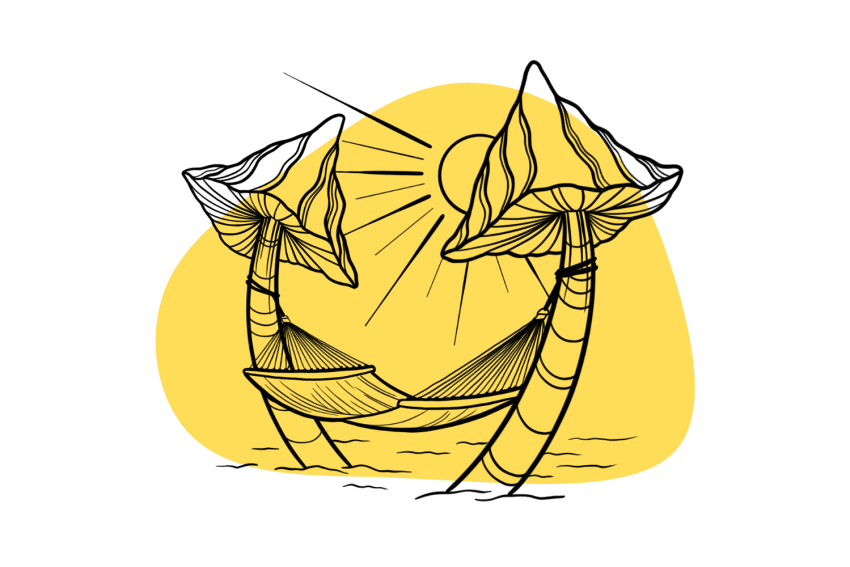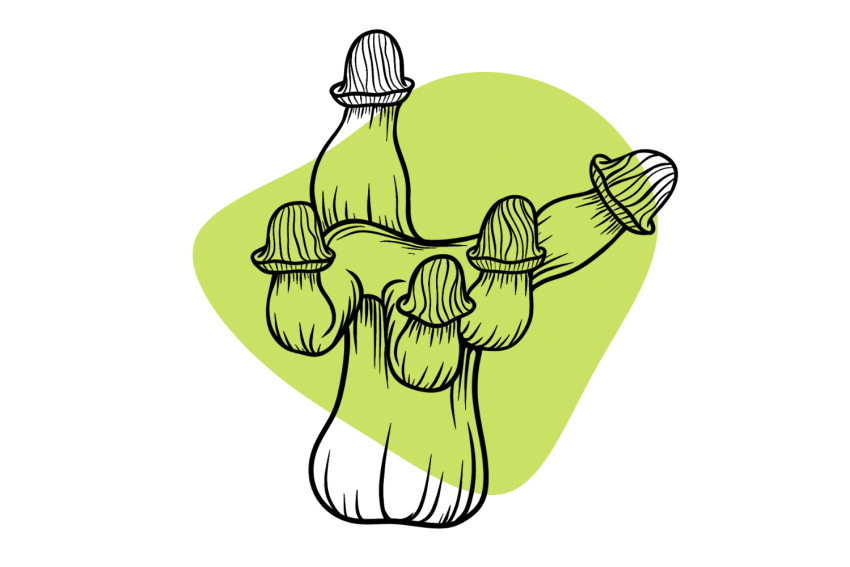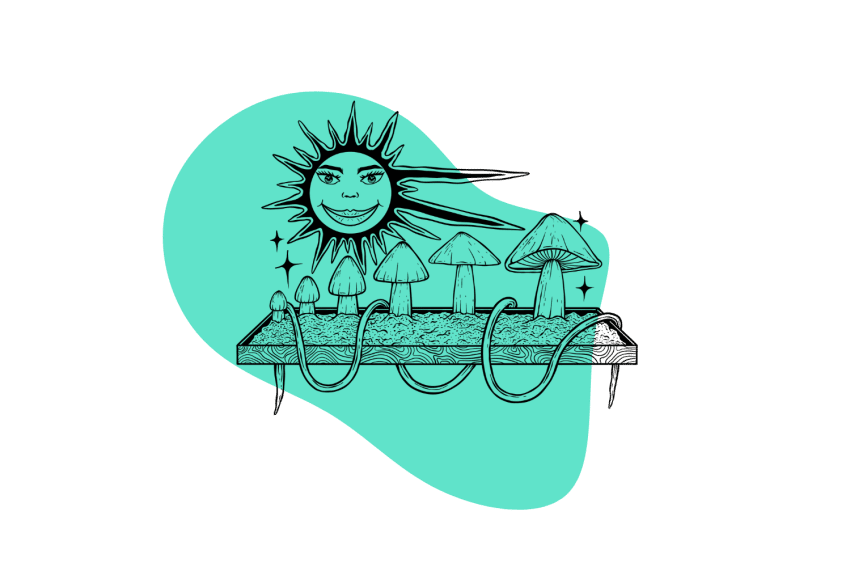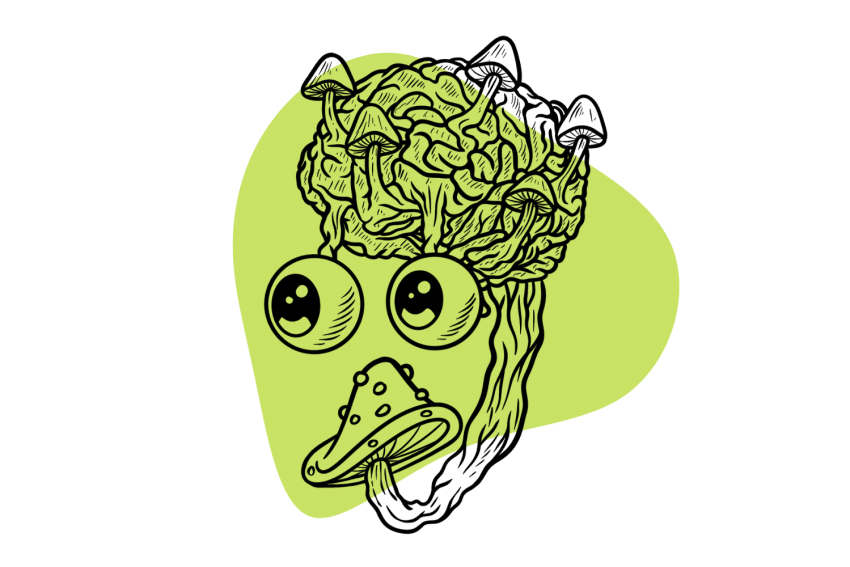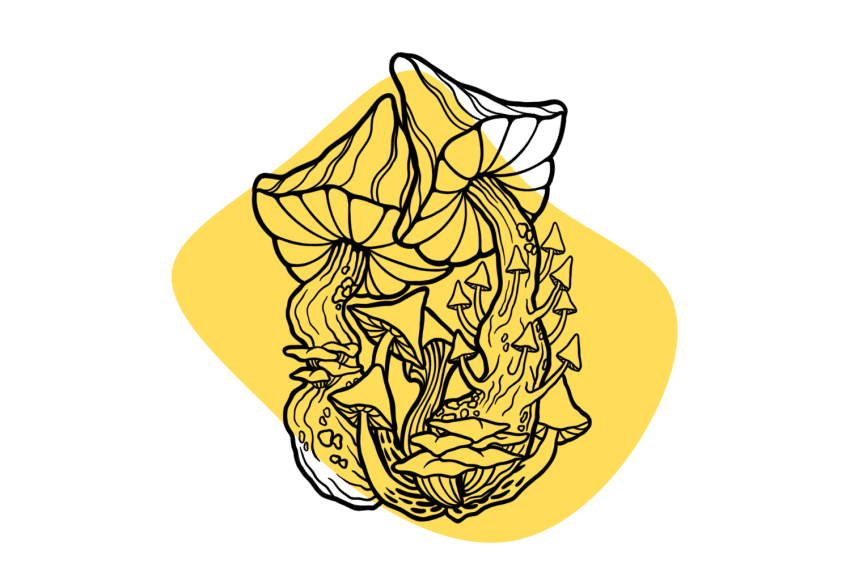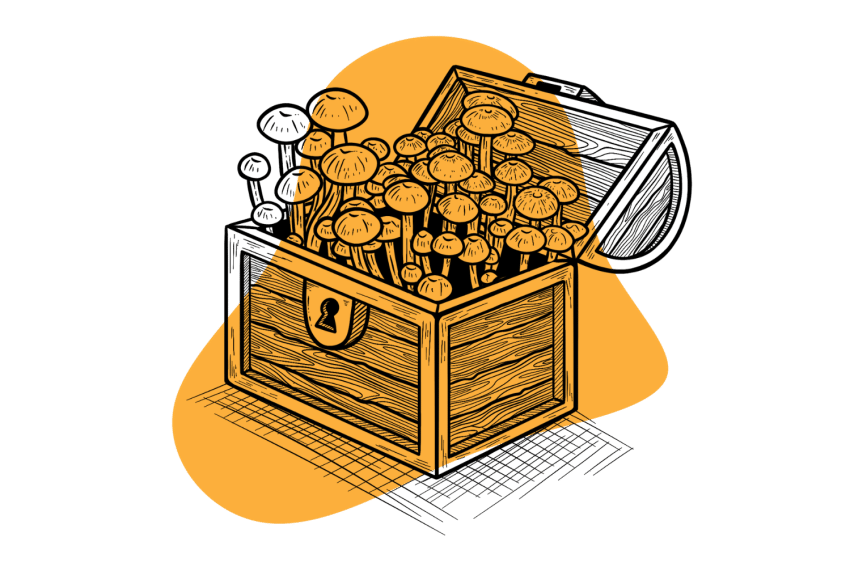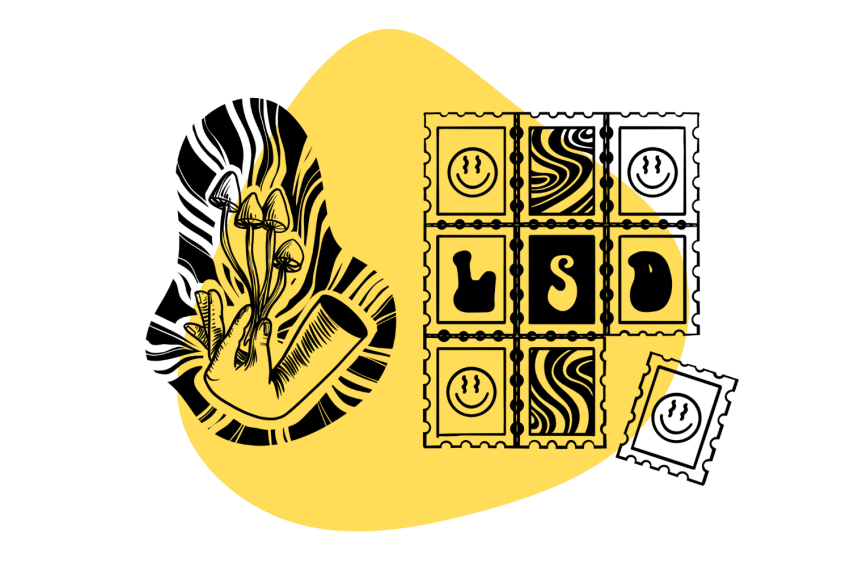What Types of Mushroom Can You Find In Your Yard?
Have you spotted some unusual mushrooms growing in your yard? Let’s find out what they are and why they’re there.
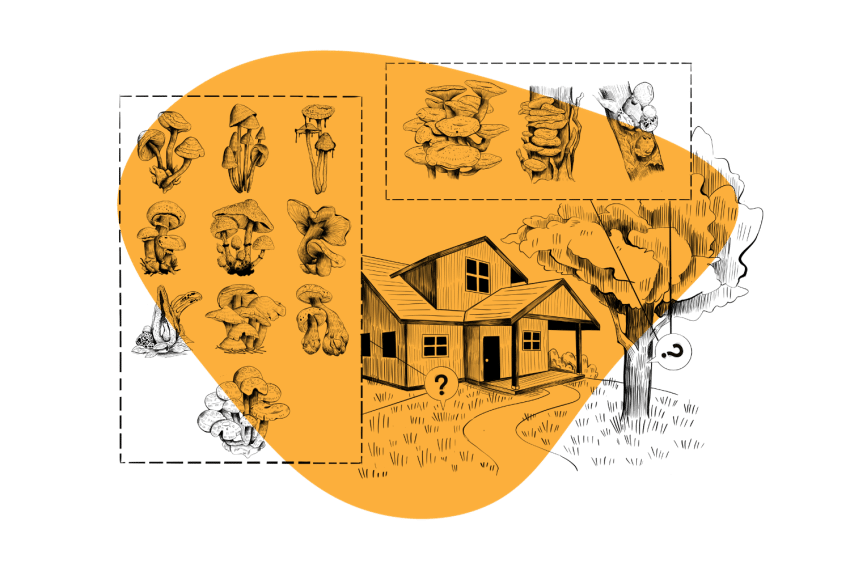
Mushrooms are everywhere. Sometimes, they’re hard to miss, with large bright caps and towering stems, and other times, they’re so minute they go unnoticed.
No matter how well-kept your yard or garden, mushrooms will appear at one point or another. They’re often a sign of healthy soil, and in many cases, they can be beneficial to the plants around them. However, some mushroom species are a little more sinister, causing harm to the plants in your garden and making your children or pets sick if they happen to eat them…
In this article, we’ll be looking at what the most common yard mushrooms are in these categories:
We’ll also be looking at:
- Why mushrooms are growing in your yard
- What yard mushrooms are edible
- Which ones are dangerous
- Whether you should remove mushrooms from your yard
- Some frequently asked questions about yard mushrooms
What Are the Most Common Yard Mushrooms?
The most common Mushrooms to find in your yard are:
- Panaeolus foenisecii (Lawn Mower’s Mushroom)
- Conocybe apala (Milky Cone Cap)
- Coprinus comatus (Shaggy Mane Mushroom)
- Phallus impudicus (Common Stinkhorn)
- Agaricus campestris (Meadow Mushroom)
- Leucocoprinus birnbaumii (Flowerpot Parasol)
- Clitocybe nuda (Wood Blewit)
- Sphaerobolus stellatus (Artillery Fungus)
- Lactarius deliciosus (Milk Cap Mushroom)
You may not find all (or any) of these species growing in your yard. The type of mushrooms present on your property will depend on your location, climate, weather conditions, and habitat in your backyard.
Depending on the species, yard mushrooms grow in different areas. Some mushrooms thrive on lawns, others in flower beds, and some in mulch. Fungi are naturally present everywhere, and many of the mushrooms that pop up in your yard have likely been there for decades. However, some species arrive through the introduction of contaminated soils, woodchips, and compost.
Yard mushrooms can be broken down into four main categories based on the habitats they’re found in. These are:
- Lawn mushrooms
- Mulch mushrooms (found in flower beds & vegetable patches)
- Tree mushrooms (found growing on trees or wood)
- Mycorrhizal mushrooms (found growing at the base of trees & shrubs)
Common Lawn Mushrooms
Here are the 9 most common species of mushrooms you’re likely to spot in your lawn.
1. Agaricus campestris (Meadow Mushroom)
Recognizable by its classic “mushroom” appearance, Agaricus campestris features a rounded cap that evolves from pale to tan. It has brown gills beneath the cap and a thick white stem. It’s edible and considered safe for consumption, making it a choice for many foragers.
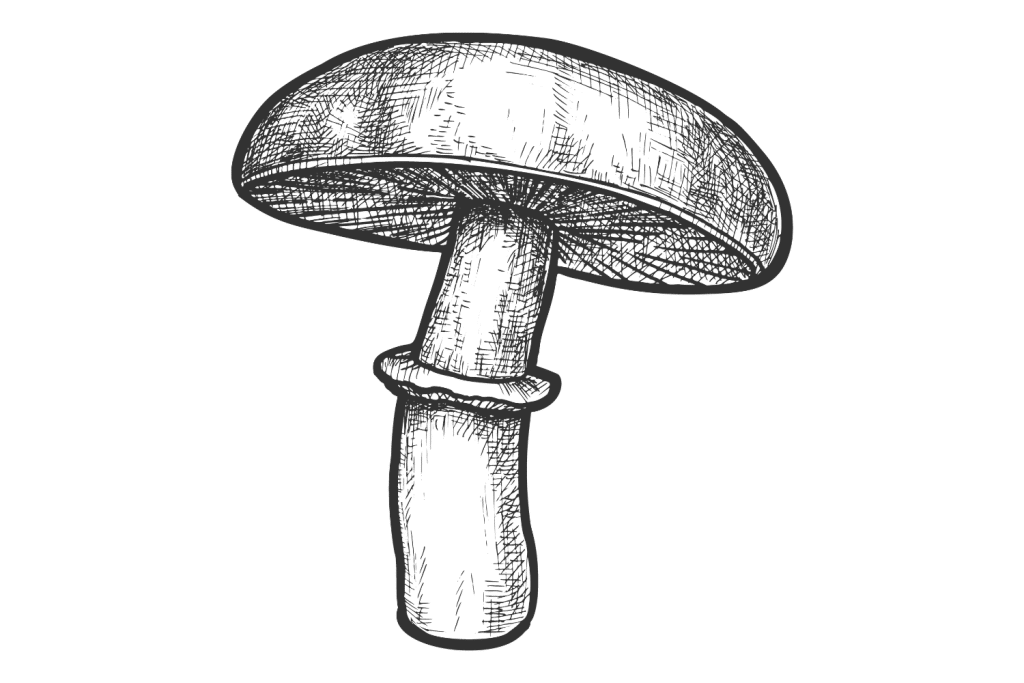
It’s also generally considered safe for your lawn and won’t affect the health of your grass. However, the cap may shade out small areas if left for a long period — leading to small discolored areas of lawn.
2. Panaeolus foenisecii (Lawn Mower’s Mushroom)
Displaying a small, tanned cap with dark gills underneath, this mushroom pops up across lawns around the world. It has a hay-like scent, and although not typically consumed due to its size and taste, it’s not considered poisonous.
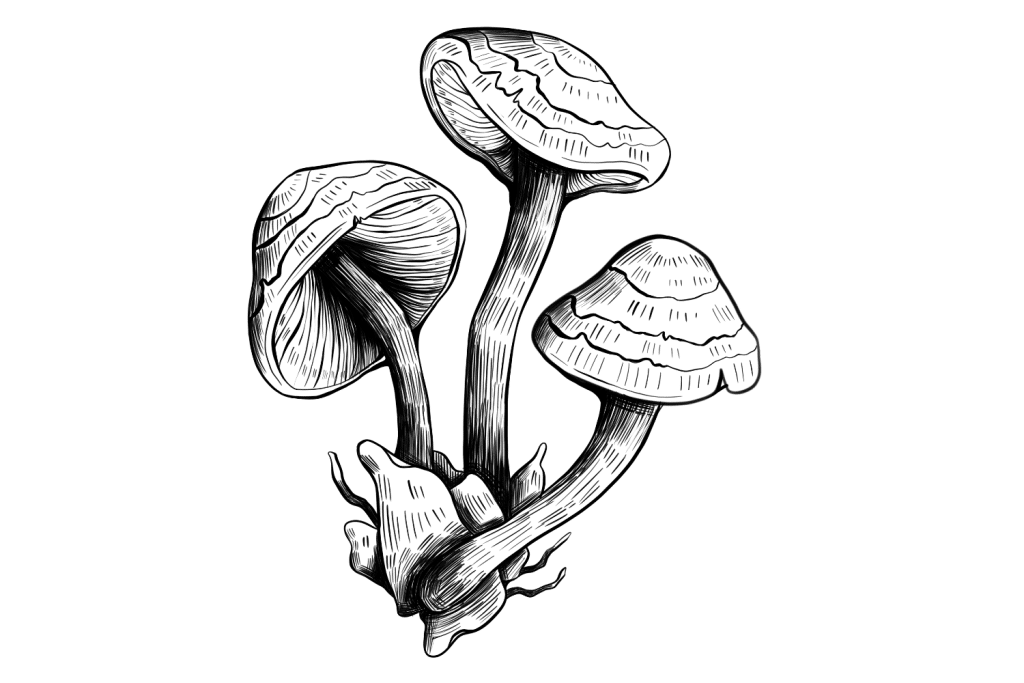
As the name suggests, these mushrooms often spring up on freshly mowed lawns. They’re harmless to the grass around them but can be annoying for those who wish to keep a “perfect” lawn because they like short grass and grow in numbers.
3. Conocybe apala (Milky Cone Cap)
As the common name suggests, this mushroom sports a milky, conical cap and slender stem. Conocybe apala blends into grassy areas unnoticed with its light coloration and small size. However, it’s noticeable on well-mown lawns.
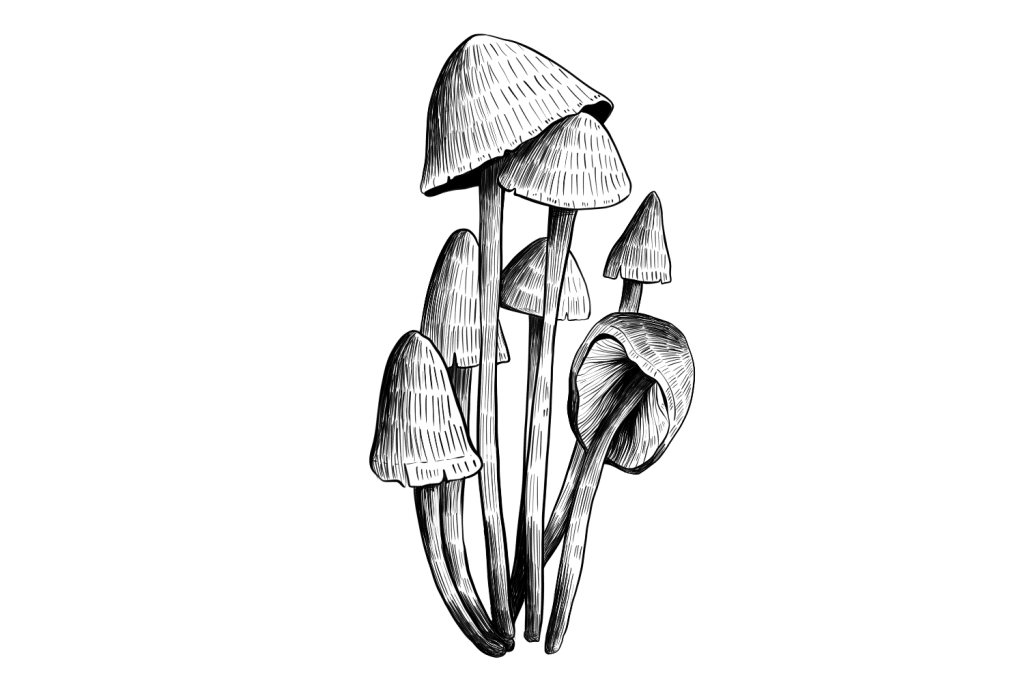
The Milky Cone Cap is potentially toxic and not recommended for consumption. Although this Conocybe species’ toxicity is unknown, other species in the genus contain phallotoxins, which can be deadly.
Conocybe apala isn’t directly detrimental to your lawn, but its potentially toxic nature makes it less desirable from a safety standpoint if you have pets or children around.
4. Phallus impudicus (Stinkhorn Mushroom)
Unmistakable due to its phallic shape and overwhelming odor, Phallus impudicus begins life as a small, white egg-like structure before transitioning to a foul-smelling shaft with a brown, slimy head. This mushroom releases a stench that mimics rotting flesh. This scent attracts flies to its cap that then unknowingly transport its spores to new locations.
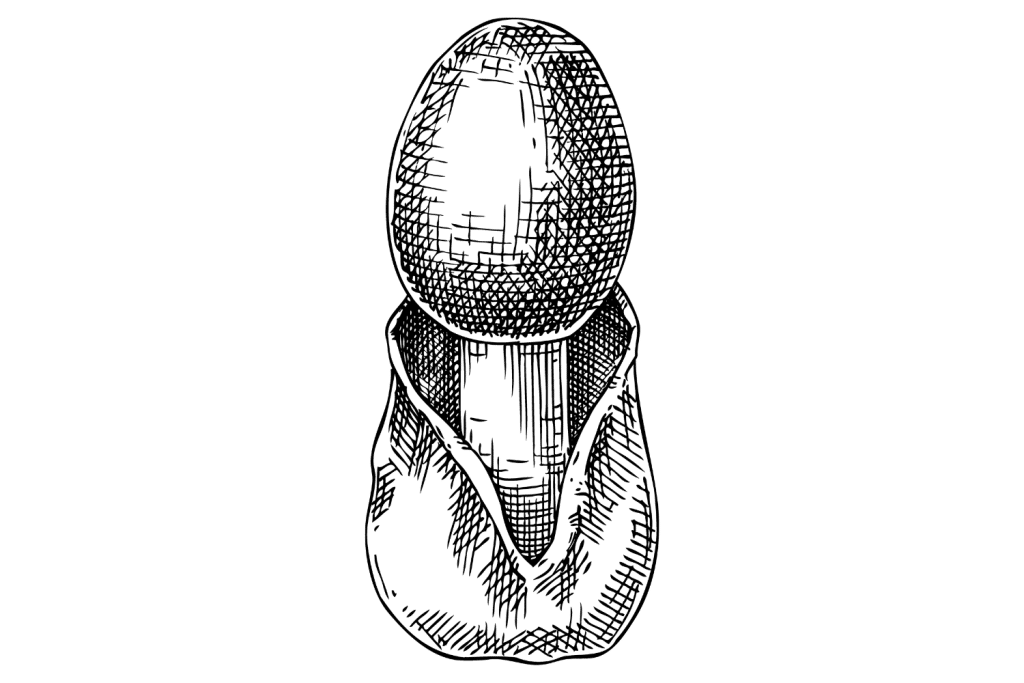
Although the smell of a mature Phallus impudicus mushroom is enough to make you vomit, it’s far less smelly when concealed in its egg-like veil. During this early phase of growth, it’s actually edible, with a crisp and crunchy radish-like taste. However, once mature, it’s considered inedible — you wouldn’t want to walk near a mature Stinkhorn, let alone put it anywhere near your mouth.
While not directly harmful to lawns, its presence might be unsightly, and its stench off-putting — especially if you like to sit outside to eat your lunch.
5. Marasmius oreades (Fairy Ring Mushrooms)
Featuring small, caramel-colored caps that sit atop wiry stems, Marasmius oreades form the characteristic “fairy rings” in lawns and grasslands across Europe and North America. Although these rings can look quite intrusive, these mushrooms aren’t detrimental to lawn health — they actually enhance soil health and biodiversity.
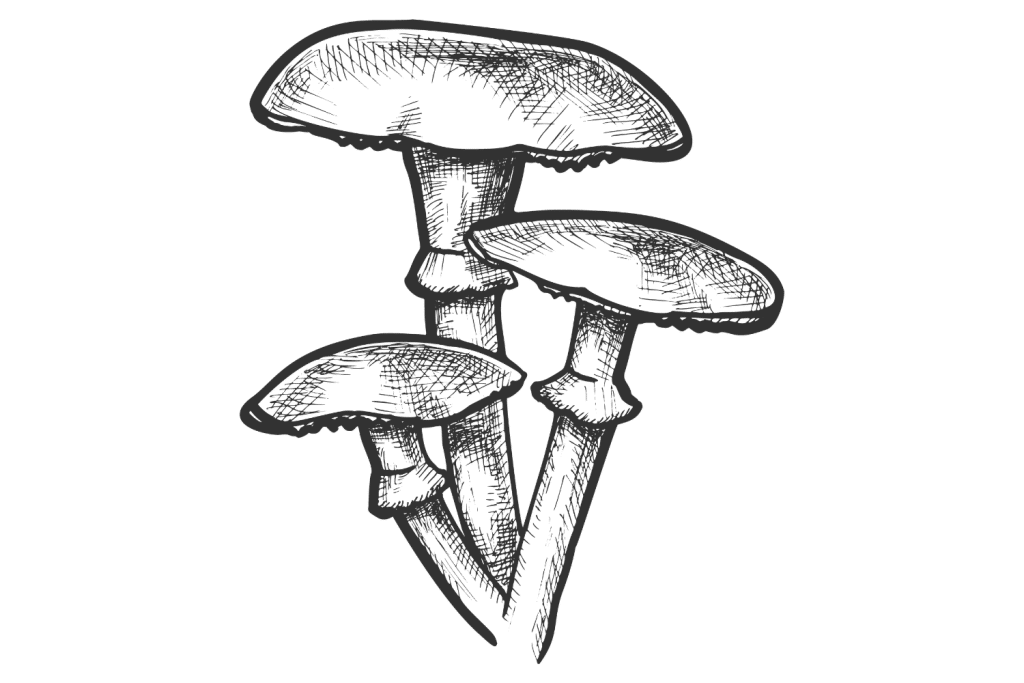
Marasmius oreades are edible and safe for consumption. They have a sweet taste and work brilliantly as a base for pasta and meat sauces.
6. Coprinopsis atramentaria (Common Ink Cap Mushroom)
Displaying a small and delicate cap, Coprinopsis atramentaria turns inky black from the edges as it matures — hence the common name. Young mushrooms have light-brown, conical caps and sit low to the ground. Older mushrooms sprout towering stems that support an opening cap that “melts” an inky blackness from its edges.
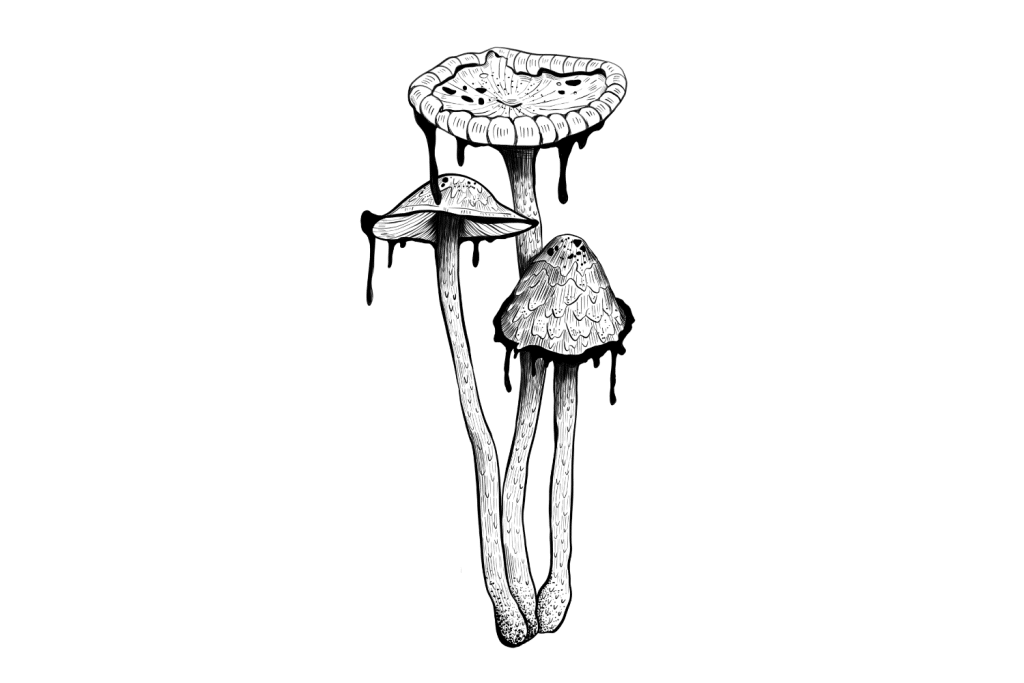
Surprisingly, Coprinopsis atramentaria mushrooms are edible when young, as long as they’re consumed before they start to turn “inky.”
These mushrooms aren’t harmful to lawn health but can grow in large, unsightly clusters over a wide area.
7. Psilocybe semilanceata (Liberty Cap Mushroom)
With a distinctive conical cap with a nipple-like protrusion in the center, this small mushroom grows (mostly hidden) across lawns, fields, and pastures in parts of North America and much of Europe. This mushroom produces the psychedelic compounds psilocybin and psilocin — inducing a hallucinogenic effect when consumed.
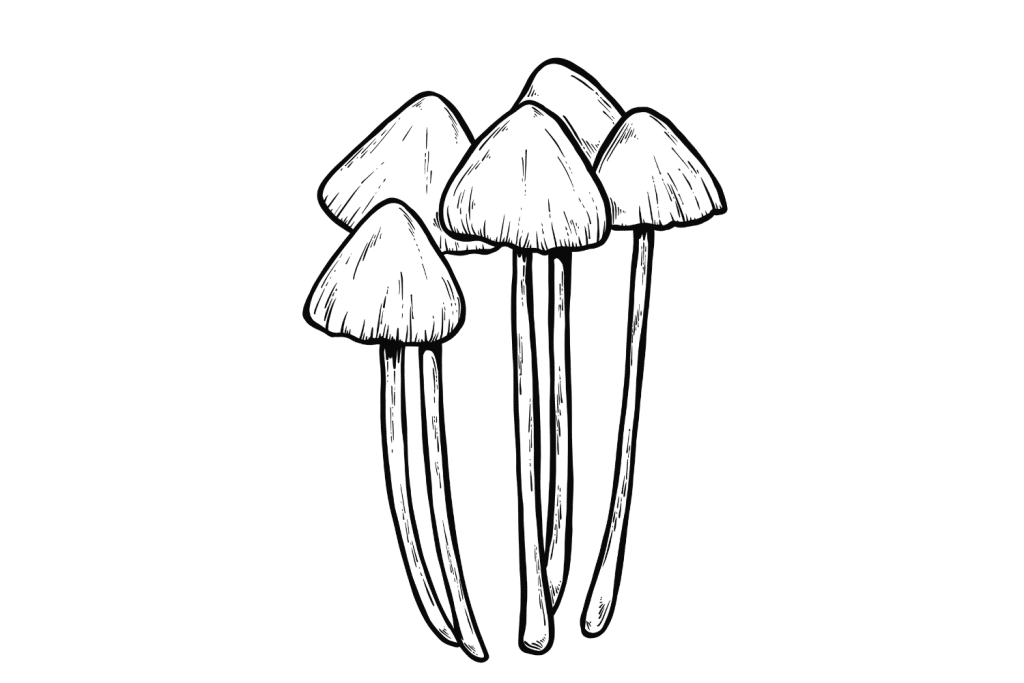
Although Liberty Cap mushrooms aren’t harmful to your lawn and often go unnoticed, if you have young children around, you may want to control their growth. Although these mushrooms aren’t deadly, they’ll induce a strong “trip” if eaten. They’re also illegal to pick and consume in many places.
8. Calvatia gigantea (Giant Puffball)
As the common name suggests, Giant Puffball mushrooms can grow to enormous sizes. These mushrooms are white when young, resembling a rounded ball with no noticeable stem or recognizable cap.
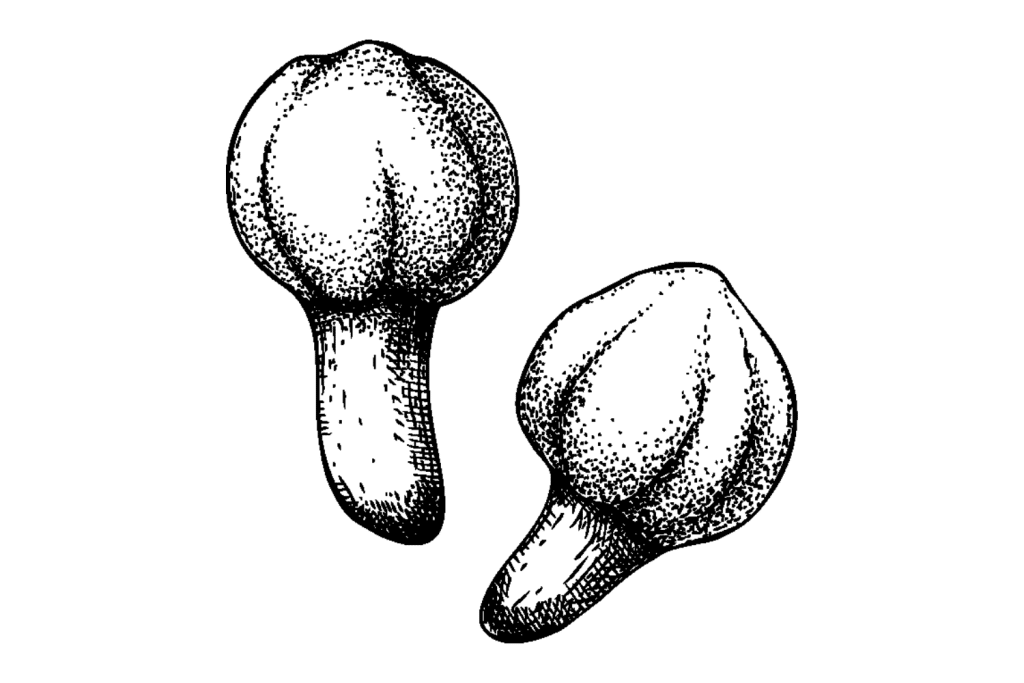
Giant Puffballs are edible when young as long as the flesh inside is white. They’re harmless to lawns, but their size means they’ll block light getting to the grass below them. They also release a thick cloud of gray spores when they sporulate, which can spread the species to other areas of lawn and cover nearby furniture in a layer of dust.
9. Coprinus comatus (Shaggy Mane Mushroom)
Characterized by its shaggy appearance, the cap of Coprinus comatus starts elongated and white, turning inky as it develops atop a tall, slender stem. This species is remarkably similar to Coprinopsis atramentaria (Common Ink Cap) and is part of the same family.
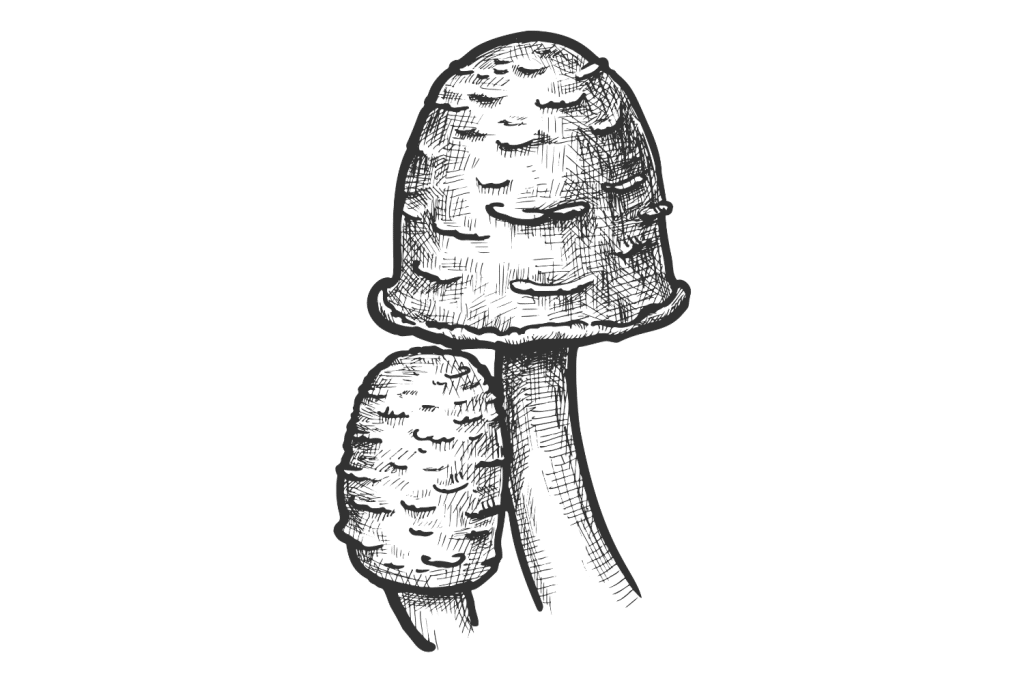
Shaggy Mane mushrooms are edible when young before they start to turn black and inky.
While not harmful to lawn health, its appearance might not be preferred by some and large clusters can appear over wide areas of lawn.
Common Mulch Mushrooms
Here are 6 of the most common species of mushrooms you’ll find growing from mulch in your garden beds or alongside your walkway. These wood-loving mushrooms are also abundant in parks and public gardens.
1. Stropharia rugosoannulata (Wine Cap Mushroom)
Characterized by its reddish-brown cap, white creamy stipe, and distinctive annulus, this choice edible is favored for its wine-like hue and earthy, nutty flavors. Its presence in the yard can be beneficial to mulch, vegetable beds, and flower beds as it helps break down organic matter, enriching the soil.
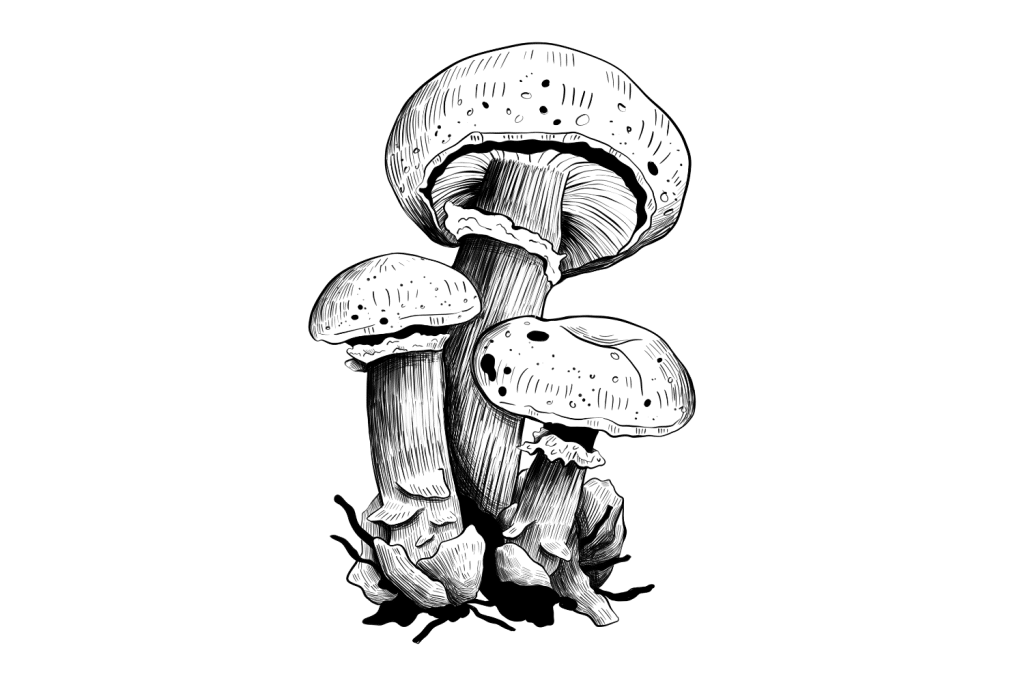
If you see this species in your flower or vegetable beds, leave it be or bring it to the table — ensuring you’re 100% confident of its identity before consumption.
2. Leucocoprinus birnbaumii (Flowerpot Parasol)
Leucocoprinus birnbaumii — also known as the Flowerpot Parasol — is a common mushroom species that is found in vegetable and flower beds, greenhouses, and (you guessed it) flower pots. This species is commonly propagated when contaminated compost and potted plants are brought into the yard from a garden center.
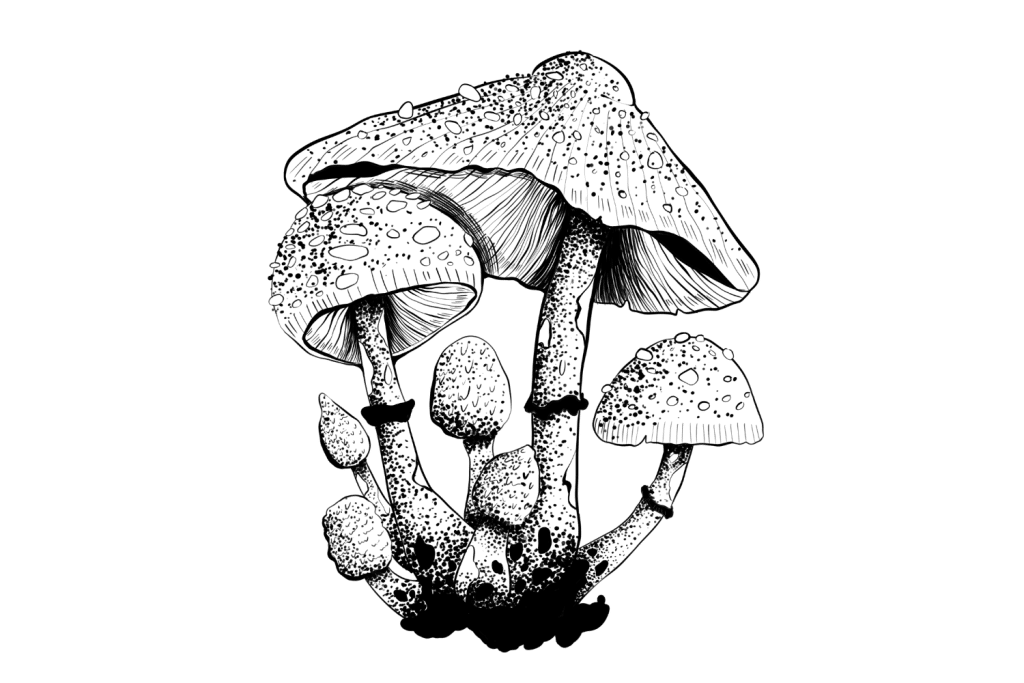
Flowerpot Parasols are toxic and should not be consumed. They don’t harm the plants around them and help enrich the soil by breaking down organic matter. However, due to their toxicity, they’re best removed as they sprout if young children or pets have access to the area.
3. Psilocybe cyanescens (Wavy Cap Mushroom)
Psilocybe cyanescens — otherwise known as “Wavy Cap” mushrooms — is a wood-loving fungus that thrives in mulch. These mushrooms can be a common sight in vegetable gardens in the northern states of the US, parts of Canada, and select areas in Europe. They have white stems and brown caps that have an undulating rim — hence the common name.
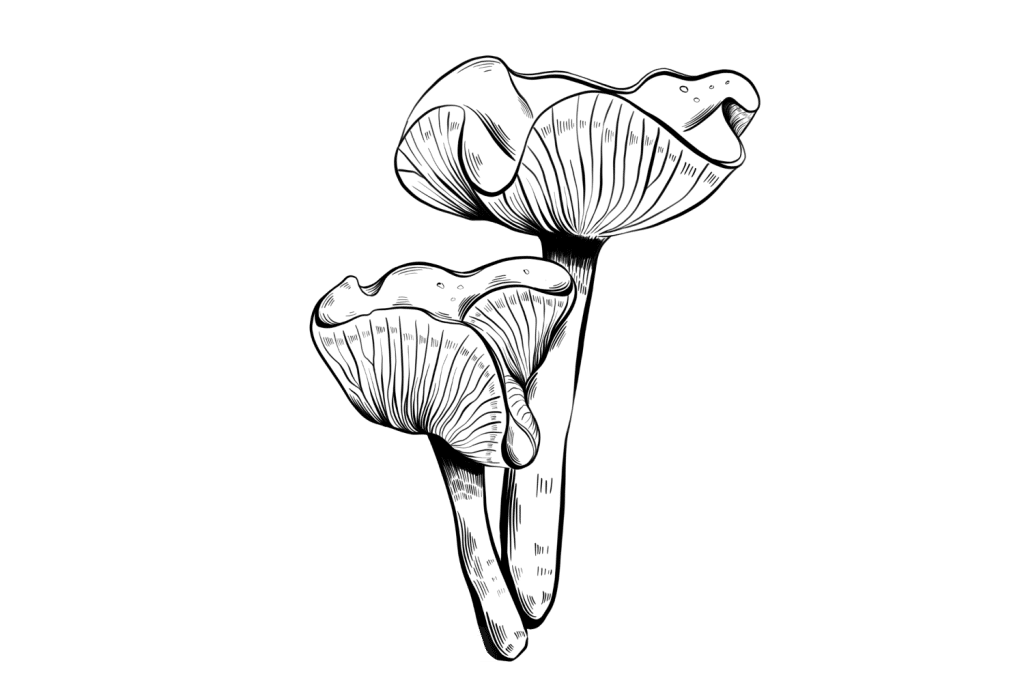
These mushrooms are beneficial to vegetable and flower beds because they enrich the soil by degrading organic matter. However, these little helpers have more to them than meets the eye. P. cyanescens mushrooms contain high levels of psilocybin and psilocin — psychoactive compounds that cause hallucinations.
Illegal to harvest and consume in many countries, Wavy Cap mushrooms should be avoided if they’re found growing in your yard unless you desire a spiritual journey…
If young children have access to your yard and you see these unassuming but potent mushrooms growing in your beds, it’s probably best to remove them.
4. Clitocybe nuda (Wood Blewit)
Clitocybe nuda — also known as the Wood Blewit — is a common wood-loving mushroom that can be found growing in vegetable and flower beds across North America and Europe. This species produces a distinctive bluish-purple cap that can grow up to 15 centimeters in diameter.
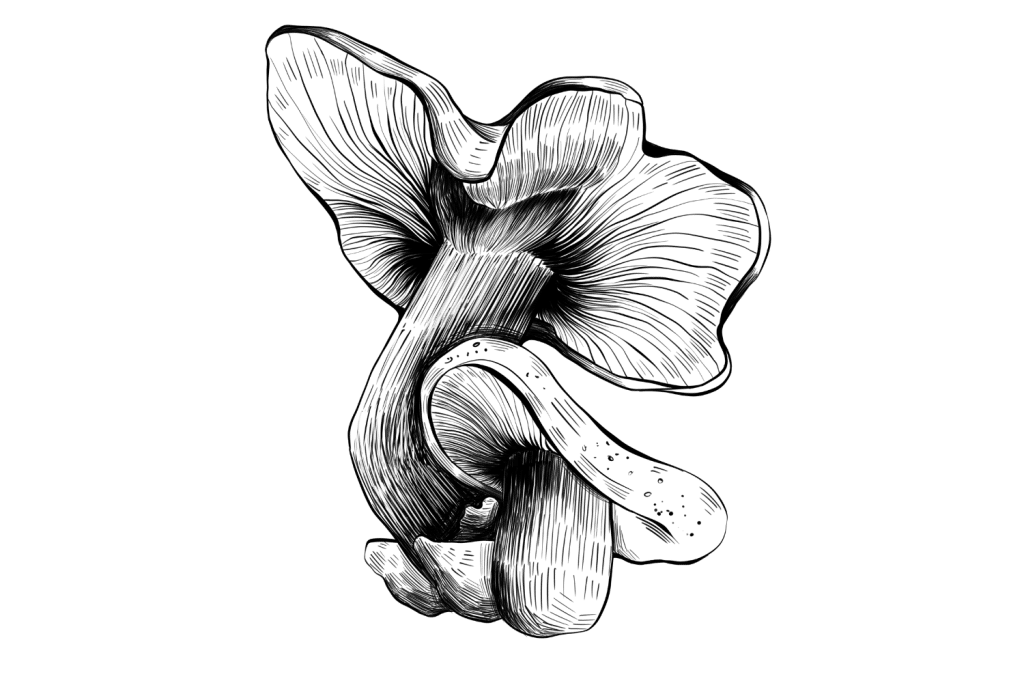
Wood Blewit mushrooms are edible with a floral, slightly acidic taste and a tough, meaty texture. However, they look similar to some Cortinarius species — many of which are poisonous. Great care should be taken during identification if you decide to bring these mushrooms to the table.
This species isn’t harmful to have in your yard. Its mycelium is aggressive and helps convert organic material into readily available nutrients for the plants that grow in your vegetable and flower beds.
5. Pseudocolus fusiformis (Stinky Squid Mushroom)
The Stinky Squid Mushroom (Pseudocolus fusiformis) is a peculiar mushroom that gets its name from its unusual appearance and foul odor. This mushroom starts life as an “egg,” like many Stinkhorn mushrooms. As the mushroom matures, the egg-like sack ruptures, revealing a long, slender, fruiting body that resembles a squid or octopus tentacle.
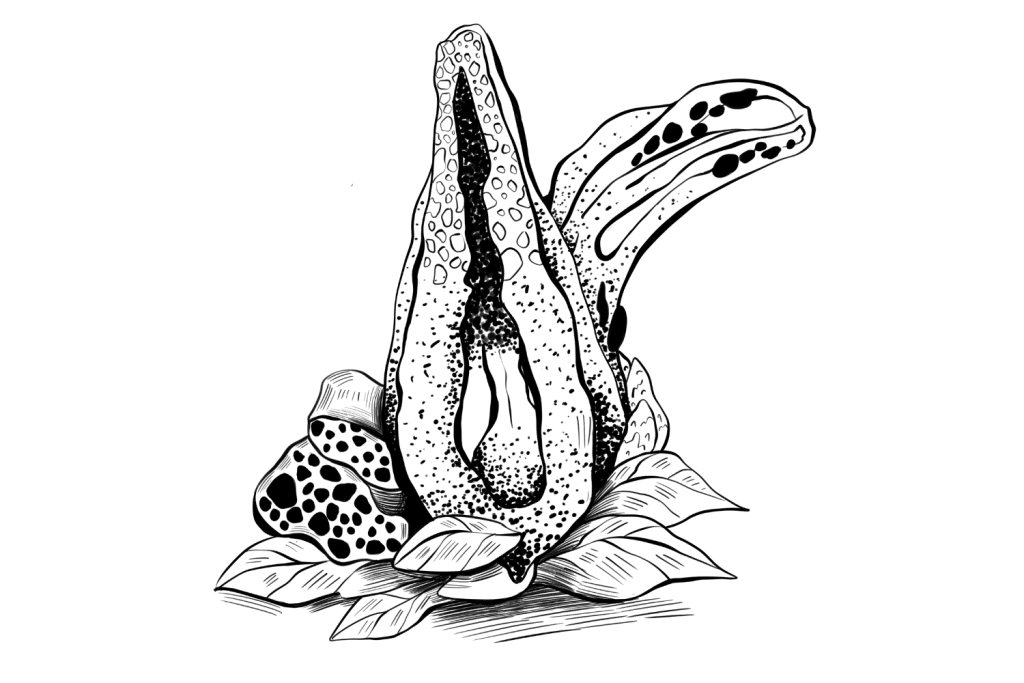
The fruiting body of Pseudocolus fusiformis is slimy and emits a strong smell comparable to rotting flesh. This odor attracts flies and other insects, which help disperse the mushroom’s spores to new locations.
These mushrooms can be found in mulch beds across the southern parts of the United States, Central and South America, Asia, and Australia. The mushrooms often appear in mulch beds and compost bins when a fly carrying its spores comes to feed or lay eggs on the rotting food waste that may reside within.
Although the toxicity of Pseudocolus fusiformis isn’t known, it’s not considered edible. These mushrooms don’t do any harm to your yard, but their foul stench isn’t appealing. You may want to remove these mushrooms when they’re in the egg stage if you spend a lot of time in your yard during fall.
6. Sphaerobolus stellatus (Artillery Fungus)
Sphaerobolus stellatus gets its common name, the “Artillery Fungus,” from its unique method of spore dispersal. They can be found thriving on mulch and rotting wood in yards across the United States, Canada, and Europe.
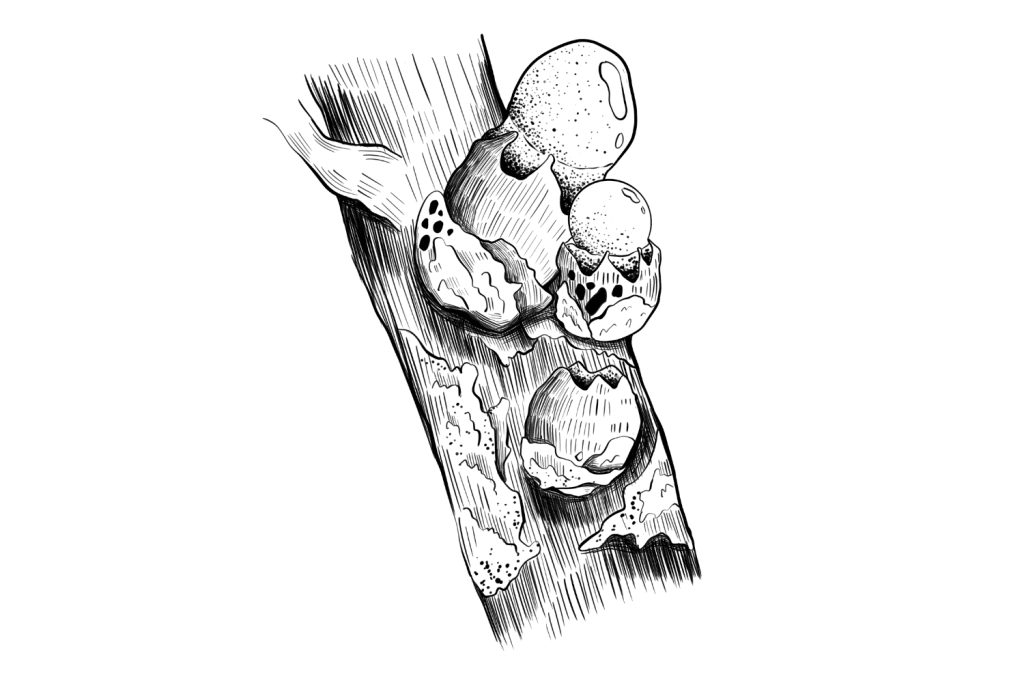
Although small, this mushroom can be a bit of a nuisance if it’s found in your yard. The Artillery Fungus shoots its sticky, black spores into the air up to 20 feet away from the mushroom itself. These spores can stick to outdoor furniture, the siding of your house, windows, doors, and any other smooth surfaces.
If these spores aren’t cleaned off within a week or two, they can permanently stain whatever they land on. Fungicides don’t work on this species, and they must be removed by hand. If you attempt to remove this fungus manually from your yard, make sure to wear old clothes — the spores can be difficult to remove from anything they land on.
Although the fruits are inedible and the spores of this pesky mushroom can be annoying to homeowners, they aren’t harmful to pets, plants, or children.
Common Tree Mushrooms
This list of mushrooms is only found growing out of dead (or almost dead) trees. They’re saprophytes, which means they prefer to live inside and consume the woody parts of trees.
1. Armillaria tabescens (Ringless Honey Mushroom)
Armillaria tabescens — commonly known as the Ringless Honey Mushroom — is a saprophytic and parasitic fungus that’s closely related to the infamous Armillaria mellea (Honey Fungus).
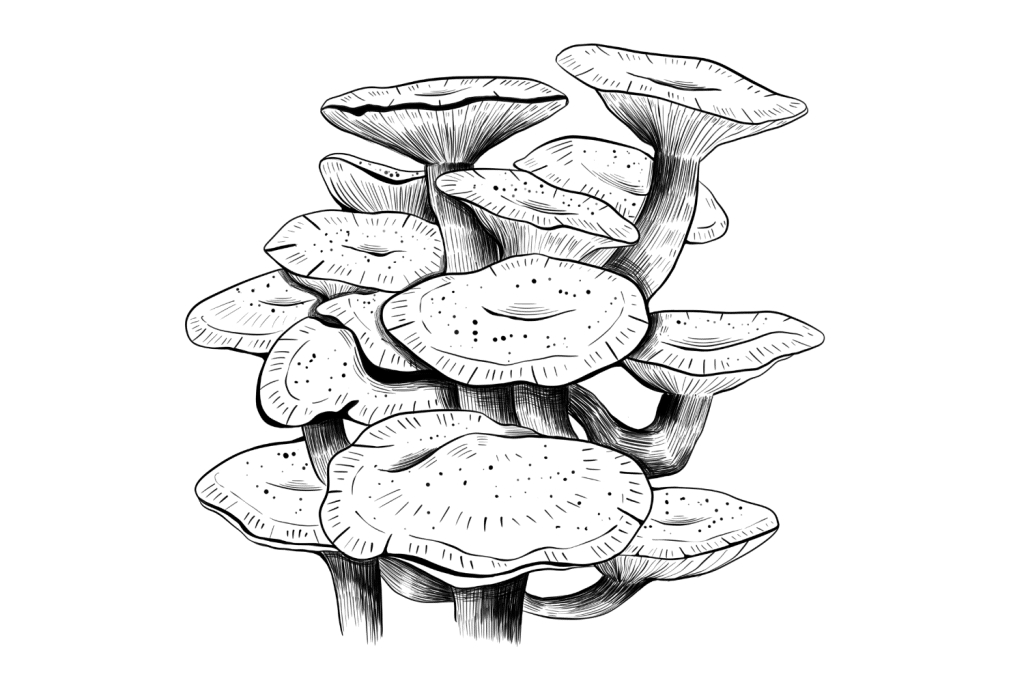
Mushrooms in the Armillaria genus are a feared sight among gardeners. The Ringless Honey Mushroom feeds on a living host. The fungus enters through wounds in the bark or weakened areas and eventually rots the trees from the inside out. Eventually, the fungus will cause the tree to decline and die.
If these mushrooms are present in your yard, an experienced arborist (tree surgeon) should be contacted. They will be able to assess the rate of decay of the tree and whether the fungus can be destroyed or the tree needs to be removed entirely.
These mushrooms are generally considered edible and non-toxic when cooked thoroughly.
2. Hypholoma fasciculare (Sulfur Tuft)
Hypholoma fasciculare — known commonly as the Sulfur Tuft — is a wood-loving mushroom that can be found growing on decaying wood. Although this species isn’t parasitic like other species in the Armillaria genus, it can be an indicator of an underlying health issue with the trees in your yard.
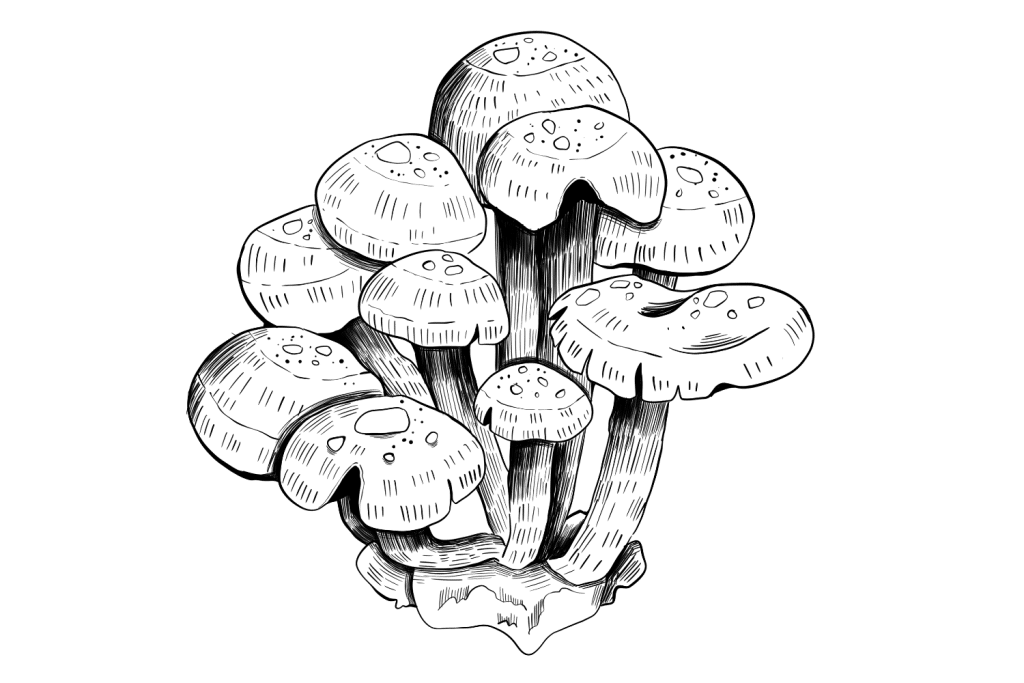
The presence of Sulfur Tuft mushrooms on a tree or other woody plant could indicate that the plant is in a state of decay. While the mushrooms themselves are not causing harm to the living plant, the underlying decay could be a sign of stress, disease, or other issues affecting the organism.
Although these mushrooms can be a sign of an underlying issue in living plants, they can be beneficial to your yard. If they’re growing on logs and known dead trees, they can help break down the organic matter and enrich the soil.
Sulfur Tuft mushrooms can be mistaken for similar-looking edible species. However, these mushrooms are toxic. If you have pets or inquisitive children that frequently roam the yard, it’s wise to remove this fungus.
3. Ganoderma applanatum (Artist’s Bracket)
Ganoderma applanatum is also known as the Artist’s Bracket, Artist’s Conk, and Shelf Fungus, depending on where you live. This wood-loving fungus grows on decaying wood. It’s a saprophytic mushroom that helps enrich the soil by decaying wood.
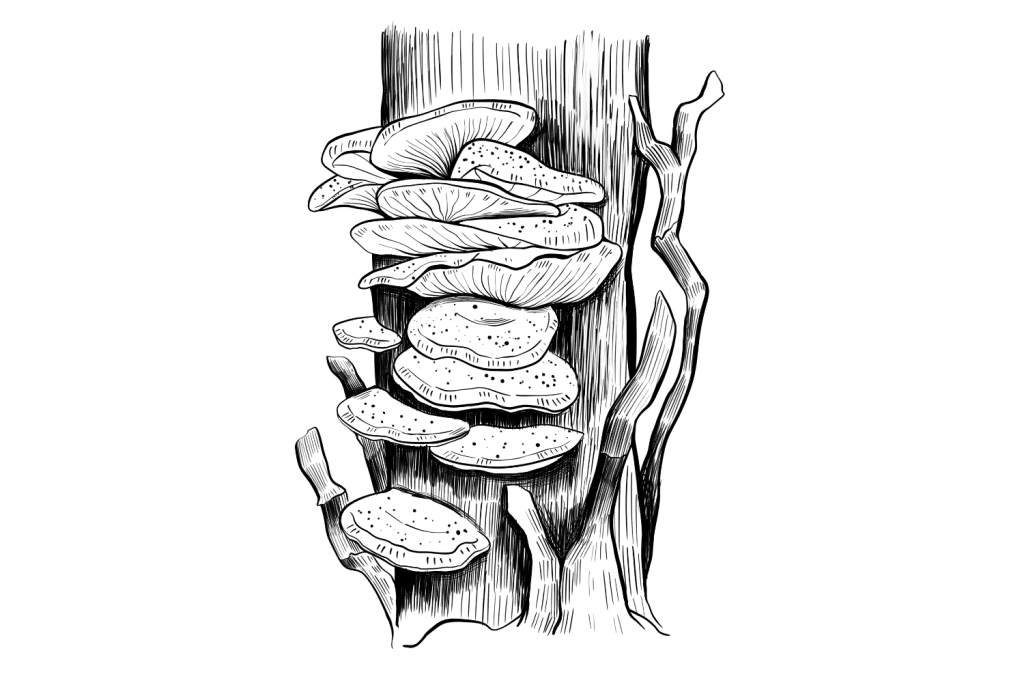
Although primarily saprophytic, Ganoderma applanatum can be an opportunistic pathogen, meaning that it may colonize trees that are already weakened or wounded from other factors. If it’s found on living trees or woody shrubs, it can be an indicator of an underlying problem.
This species isn’t directly harmful to the plants in your yard, but where it’s located can be a problem. If it’s found on deadwood, it can benefit your yard by enriching the soil, whereas if it’s found on a sick plant, it can speed up the process of decay.
Although considered inedible due to its tough, woody texture, the Artist’s Bracket is considered low-risk.
4. Trametes versicolor (Turkey Tail Mushroom)
Trametes versicolor — commonly known as the Turkey Tail Mushroom — is a well-known and widely distributed mushroom species belonging to the Polyporaceae family. It’s recognized for its distinctive appearance, vibrant colors, and potential health benefits. The Turkey Tail Mushroom can be found in yards around the world, including those in North America, Europe, and Asia.
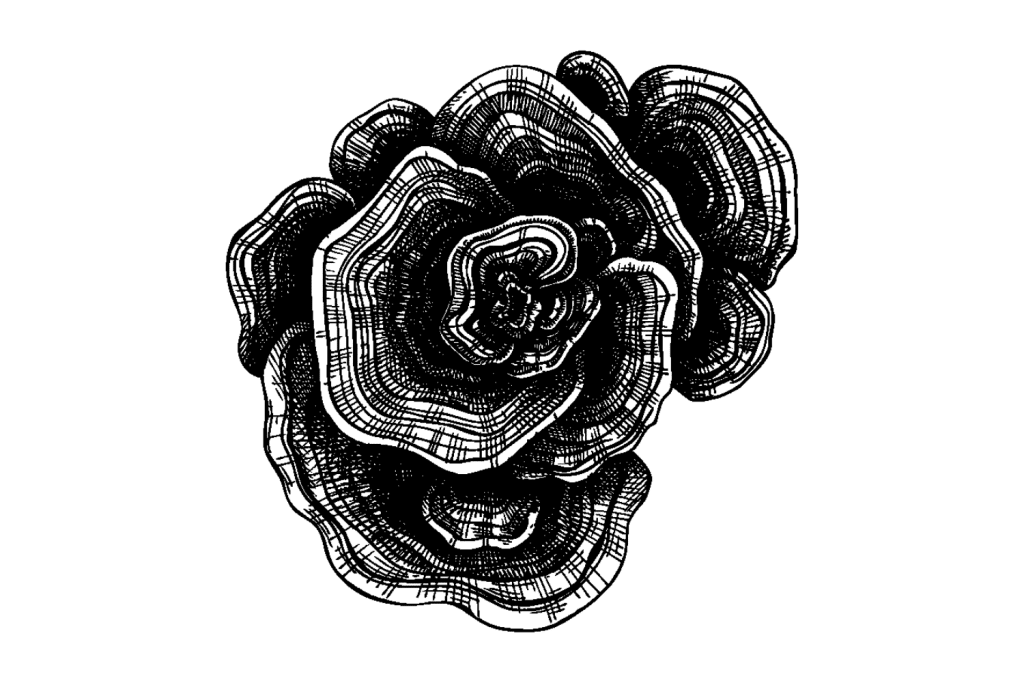
This saprophytic mushroom grows on dead wood, and like other fungi in this category, they can be an indicator of a health issue if found growing on living plants. If you’re lucky enough to find Turkey Tail mushrooms in your yard and they’re growing on deadwood, they can be beneficial to the plants within it by enriching the soil.
Although Turkey Tail mushrooms are edible, there may be other species that share similarities in appearance. It’s important to educate yourself properly before harvesting this species.
Common Mycorrhizal Mushrooms
These mushrooms are unique in that they live inside the roots of host trees. They form a complex synsergystic relationship with trees in a forest by providing rare nutrients from the soil and buffering water for the tree in exchange for sugars produced by photosynthesis inside the tree. These mushrooms will only appear near the base of their host trees. Finding these mushrooms requires finding the trees they correspond with.
1. Morchella esculenta (Common Morel Mushroom)
Morchella esculenta — commonly known as the Common Morel — is a mycorrhizal species that can be found in large, tree-filled yards across North America and Europe. This prized edible is a favorite among foragers for its unique appearance and delicious flavor.
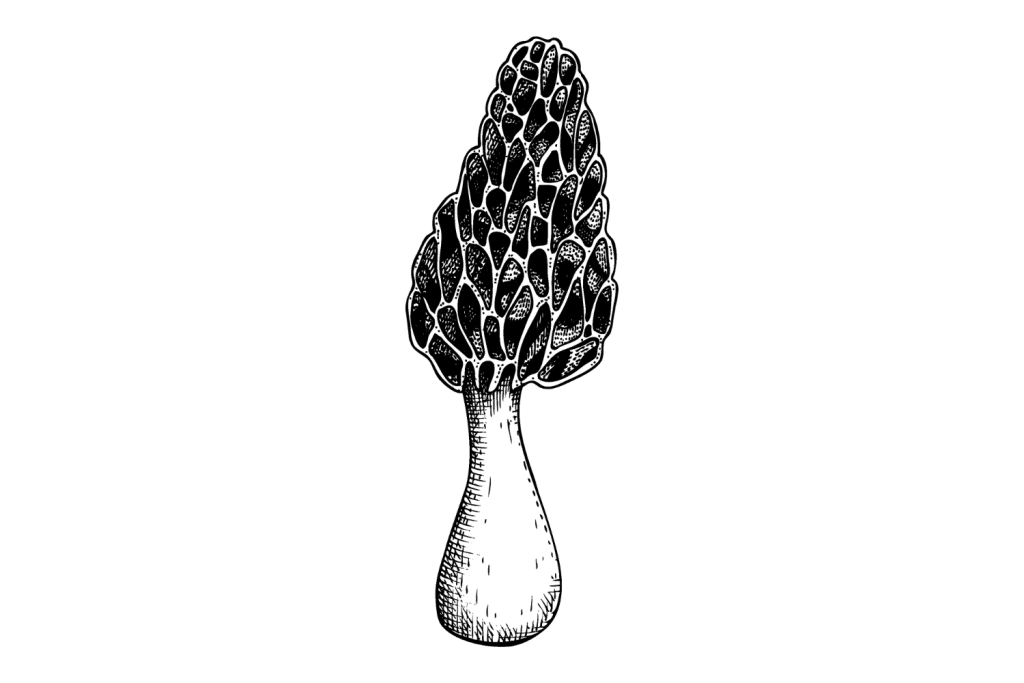
If you’re lucky enough to find Morel mushrooms in your yard, you should leave them be or harvest them responsibly. Like many mycorrhizal shrooms, they’re beneficial to their surrounding environment. They help boost nutrient and water intake for the plants they develop relationships with and help enrich the soil.
If you find these mushrooms in your yard and want to eat them, you must ensure you know how to properly identify them.
Related: Morel Mushroom Maps: Find Morels Near You
2. Amanita muscaria (Fly Agaric Mushroom)
Amanita muscaria (Fly Agaric) is the most recognized mushroom species on the planet. This mushroom’s spotted red cap is a common sight in forests and large woody yards across the globe. Its image is implanted in our brains from its appearance in the Mario Bros. games, Alice in Wonderland, and other fairytale stories.
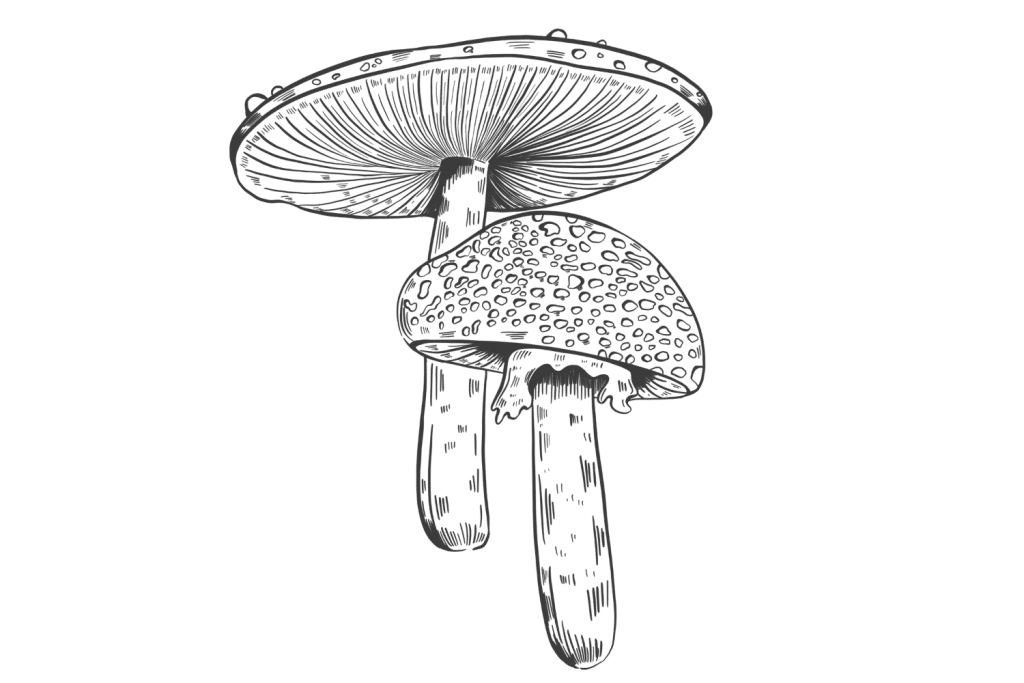
This species can be found growing under certain tree species. It has a bad rap for being toxic, but it’s not as harmful as some may portray. That being said, if you have young children and pets, you may want to remove the mushrooms or ensure they’re out of reach.
Related: Do Amanita muscaria Mushrooms Contain Psilocybin?
3. Boletus edulis (Porcini Mushroom)
Boletus edulis — also known as the Porcini or Penny Bun mushroom — is a prized edible that forms mycorrhizal relationships with both coniferous and deciduous tree species.
This species is beneficial to the trees and plants it forms relationships with and the environment around them. Being edible, they can be left in your yard even if you have pets or young children.
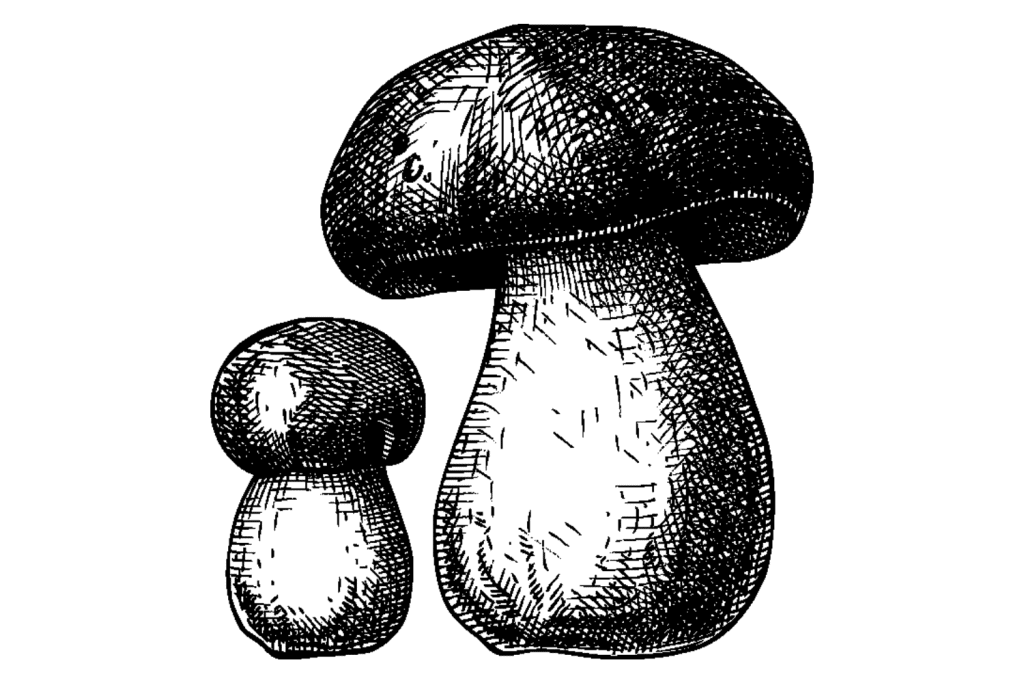
If you decide to harvest Penny Buns from your yard, it’s important to learn how to identify them properly. There are some toxic lookalikes in the genus, and some can grow a fungus that causes stomach upsets if ingested.
4. Russula emetica (The Sickener)
Russula emetica is a common mycorrhizal species that can be found growing under trees in yards across North America and Europe. Commonly known as “The Sickener,” this mushroom is toxic and can cause nausea and vomiting if eaten. It’s known for its bright red or orange cap and pale white gills.
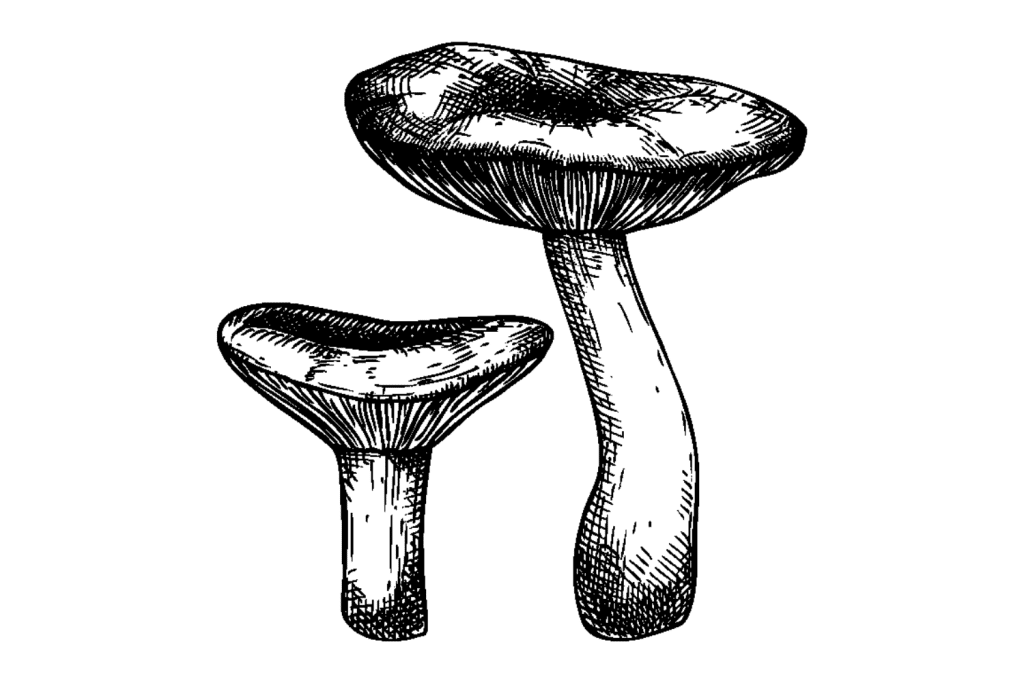
This species is beneficial to have in your yard, but if you’re worried about children or pets getting their hands on it, you may want to remove it. It’s not a deadly mushroom, but you don’t want to eat it.
5. Lactarius deliciosus (Milk Cap Mushroom)
Lactarius deliciosus — commonly known as the Milk Cap, Saffron Milk Cap, or Delicious Milk Cap — is a prized culinary mushroom that can be found growing in woodlands and tree-filled yards across the globe.
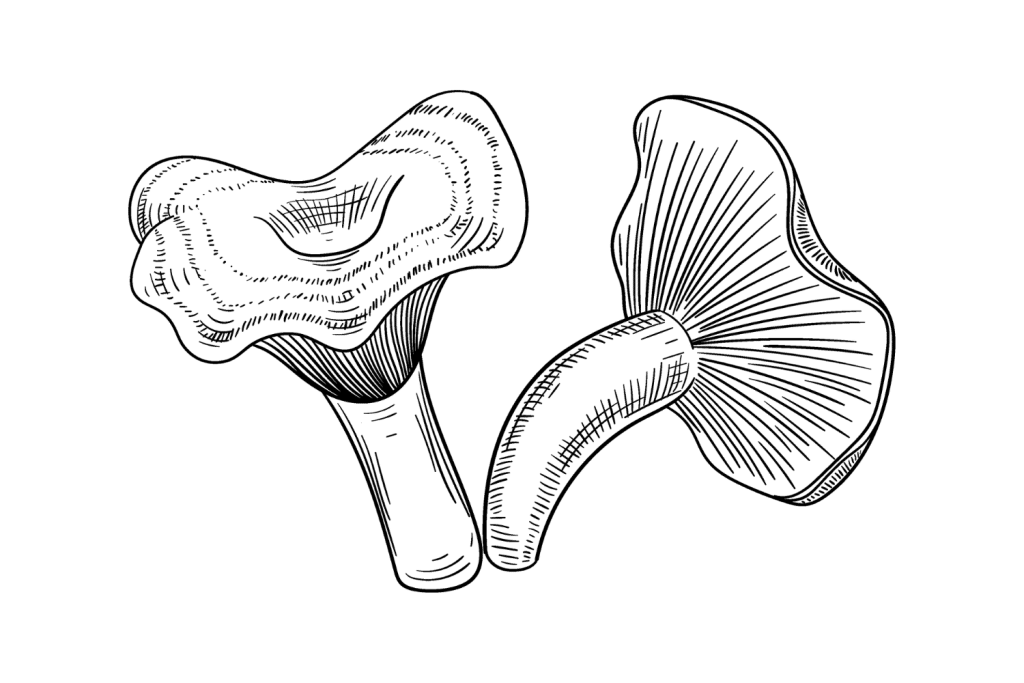
This species is beneficial to your yard as it helps improve nutrient and water absorption in the plants it forms mycorrhizal relationships with. Being edible, it’s also considered safe. However, when eaten raw, it can lead to gastric upset or discomfort in some people.
As with any wild mushroom, if you find Milk Cap mushrooms in your yard and plan on eating them, you must ensure you have a proper ID on the species. You should also cook this species thoroughly before consumption.
6. Tricholoma terreum (Grey Knight Mushroom)
Tricholoma terreum — commonly known as the Grey Knight Mushroom — is a species of mushroom belonging to the Tricholomataceae family. This is a common species found in woodlands and woody yards in various parts of Europe. It’s known for its distinctive appearance, with its gray cap and shape similar to Button Mushrooms.
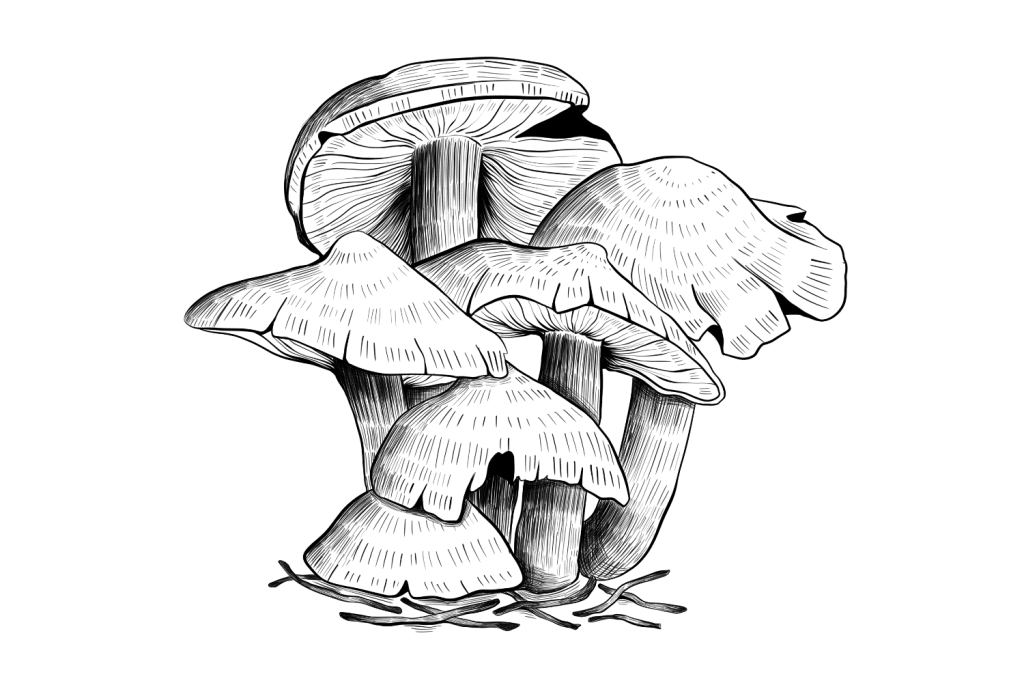
Grey Knight Mushrooms are considered by some sources to be edible, with many people reporting it to have a pleasant taste. However, edibility can vary based on individual sensitivities, regional variations, and potential toxic lookalikes. If you’re inexperienced, it’s best to leave these mushrooms be.
These mushrooms are considered low-risk and can be left to grow naturally in your yard. They’re beneficial to the surrounding environment.
7. Cortinarius violaceus (Violet Webcap)
Cortinarius violaceus — commonly known as the Violet Webcap — is a species of mushroom belonging to the Cortinariaceae family. This mushroom has a striking violet-to-purple coloration and forms mycorrhizal relationships with trees.
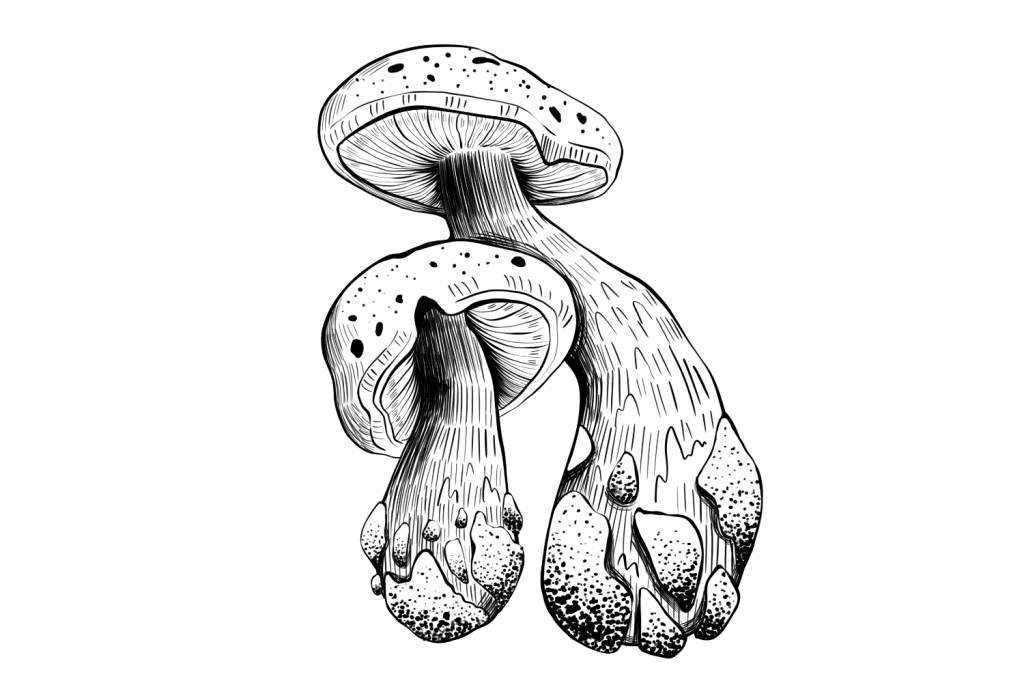
This species can be found growing across the globe in the Northern Hemisphere. It’s a common sight among yards with a diverse array of mature tree species. They’re beneficial to your yard and help promote health in the trees with which they form mycorrhizal relationships.
Like many species in the Cortinariaceae family, Violet Webcaps are inedible and potentially toxic. These mushrooms should be avoided or removed if pets and/or children frequent the yard they’re growing in.
Why Are There Mushrooms Growing in Your Yard?
Fungi and mushrooms are part of the ecosystem. A healthy biome — including the biome of your yard — will contain mushrooms of some description. Mushrooms help break down organic matter into nutrients that other organisms can consume to grow.
Mushrooms are a vital part of nature’s cycle. They help create nutrients for plants to grow; those plants then eventually die and feed the fungi that once again “digest” the organic matter and feed the plants of the next generation.
Mushrooms are a sign of a stable, productive biome — if you have mushrooms in your yard, your yard is healthy.
With that said, the presence of some mushroom species can indicate an underlying issue with moisture levels in the soil, disease in plants, an excess of rotting wood and organic material, or the introduction of an invasive species.
It’s important to note that while many mushrooms are harmless and play valuable ecological roles, some wild mushrooms can be toxic or inedible. If you’re uncertain about the identity of mushrooms in your yard, it’s best to avoid touching or consuming them.
Proper identification requires expertise, and consuming wild mushrooms without proper knowledge can be risky. If you’re interested in learning more about the mushrooms in your yard, consider speaking to a local mycologist or an expert who can provide accurate information and guidance.
Are the Mushrooms in Your Yard Edible?
Some of the mushrooms you find in your yard may be edible. We mentioned a few of these in the lists above. If you wish to eat mushrooms from your yard, it’s important to learn how to properly identify the potentially edible species that are present.
You should also be cautious about eating mushrooms from your yard if you regularly use fertilizers, pesticides, or fungicides on your lawn or flower beds. Mushrooms are bioaccumulators and can absorb toxins from their surrounding environment.
Always be cautious when foraging for wild mushrooms, whether you find them in your yard or out in nature. Never eat a wild mushroom unless you’re 100% sure of its identity.
With that said, here are a few edible mushrooms you may find in your yard:
- Agaricus campestris (Meadow Mushroom)
- Marasmius oreades (Fairy Ring Mushrooms)
- Coprinopsis atramentaria (Common Ink Cap Mushroom)
- Calvatia gigantea (Giant Puffball)
- Coprinus comatus (Shaggy Mane Mushroom)
- Stropharia rugosoannulata (Wine Cap Mushroom)
- Trametes versicolor (Turkey Tail Mushroom)
- Morchella esculenta (Common Morel Mushroom)
- Boletus edulis (Porcini Mushroom)
- Lactarius deliciosus (Milk Cap Mushroom)
Are Yard Mushrooms Dangerous?
It’s no secret that mushrooms can be deadly poisonous. However, did you know that only 1% of the world’s mushrooms are lethal?
Although the percentage of deadly poisonous mushrooms is low, it’s not uncommon to come across inedible or toxic mushrooms that can cause nausea, vomiting, or more severe health implications when ingested.
If you’re not an experienced mushroom forager, it’s unwise to pick and eat any mushrooms from your yard (or anywhere in nature) — that should go without saying. A toxic mushroom is only dangerous if it’s ingested, so as long as you avoid putting the mushrooms in your yard anywhere near your mouth, you’ll be safe.
With that said, you may have pets or young children roaming around your yard who may not understand the potential danger of mushrooms. If this is the case, it’s good to know what mushrooms lurking in your yard are potentially poisonous.
If you’re concerned about a pet or young child nibbling a mushroom in your yard, make sure they’re not left unattended. Removing mushrooms from easy-to-reach places, like your lawn, is a wise move in the fall time if you have dogs or toddlers that like to play outside.
We mentioned these species earlier, but here’s a quick list of common poisonous mushrooms you may find in your yard:
- Conocybe apala (Milky Cone Cap)
- Leucocoprinus birnbaumii (Flowerpot Parasol)
- Amanita muscaria (Fly Agaric Mushroom)
- Russula emetica (The Sickener)
- Cortinarius violaceus (Violet Webcap)
Should You Remove Mushrooms From Your Yard?
In some instances, you may want to remove mushrooms from your yard. 90% of the mushrooms you find growing in your lawn or vegetable beds are completely harmless to the plants you may be growing. However, some mushrooms may be detrimental or a nuisance.
Some fungi may be detrimental to tree and plant health, some may fire their spores over clean surfaces, and others may not fit the aesthetics of your garden.
As a general rule, you should leave the mushrooms in your yard to grow unless they’re directly harming your plants, pets, or children. Mushrooms are an important part of the ecosystem and often help enrich soils, decay organic matter, and improve nutrient absorption among plants.
With that said, here are some common yard mushrooms that may cause harm to your plants and property:
- Sphaerobolus stellatus (Artillery Fungus)
- Armillaria tabescens (Ringless Honey Mushroom)
- Ganoderma applanatum (Artist’s Bracket)
Here are some less common yard fungi that can cause harm to trees and woody shrubs:
- Armillaria mellea (Oak Root Fungus)
- Phellinus spp. (Bracket Fungi)
- Heterobasidion spp. (Root Rot Fungi)
- Sclerotinia spp. (White Mold)
- Rhizoctonia spp. (Brown Patch)
- Ustilago spp. (Smuts)
If you’re unsure whether to remove a certain mushroom or have concerns that a particular mushroom is harming your yard or is a risk to your family, consult a professional gardener or tree surgeon.
Frequently Asked Questions About Yard Mushrooms
Here are some of the questions we’ve received since initially posting this guide to mushrooms that grow in your yard.
1. Can I Grow Edible or Medicinal Mushrooms in My Backyard?
Yes. It’s possible to grow several mushroom species in your yard. The species you’re able to grow will depend on the climate in your area and the habitat you have available in your yard.
Growing mushrooms at home can be a rewarding and educational experience that brings gourmet food to the table that may not otherwise be available to you.
If you wish to grow mushrooms in your yard, it’s important to choose a suitable species for your environment. Some popular edible and medicinal mushrooms that can be cultivated at home include Oyster mushrooms (Pleurotus spp.), Shiitake mushrooms (Lentinula edodes), Lion’s Mane mushrooms (Hericium erinaceus), Button mushrooms (Agaricus bisporus), and Reishi mushrooms (Ganoderma lingzhi).
Different mushroom species require different substrates. Some are cultivated on wood, some on mulch, and others on grains. The cultivation process differs in complexity depending on the species.
If you’re interested in growing mushrooms indoors or outdoors, I highly recommend Paul Stamets’ Book titled “Growing Gourmet and Medicinal Mushrooms.”
2. How Can I Identify Mushrooms in My Yard?
Learning about the mushrooms that grow in your yard can be a rewarding experience. The world of fungi is fascinating, and identifying the mushrooms around can provide an insight into the complex ecosystem on your property.
Learning how to properly ID yard mushrooms may also surprise you. You could find potentially edible, psychedelic, or deadly poisonous mushrooms growing just feet away from your home.
Identifying mushrooms isn’t dangerous, provided you don’t eat any of the mushrooms you discover. However, if you plan on eating any of the mushrooms in your yard, you must be 100% confident in your identification skills before consuming anything.
The best way to learn about mushrooms and wild mushroom identification is to get in contact with an experienced mycologist or forager and learn from them. There may also be foraging courses in your area that’ll teach you about local edible and medicinal mushrooms and how to identify them.
If you’re not able to get in contact with an expert or take a course, educate yourself through information that’s online, in books, and on social media. The internet is a powerful place — use it to connect with people who are more experienced than you.
Join a few foraging groups on Facebook and post clear photos of your finds; other keen mushroom foragers will be happy to help you identify the species, teach you distinguishing features, and guide you toward valuable foraging resources.
3. What Are the Benefits of Having Mushrooms in My Yard?
Mushrooms are an important part of the ecosystem. They help break down organic matter and, in some cases, form symbiotic relationships with plants that boost their nutritional intake.
Here are some of the benefits of having mushrooms in your yard:
- Nutrient Cycling: Mushrooms play an important role in nutrient cycling. They help break down organic matter into more readily available nutrients that will help the plants in your yard grow.
- Ecosystem Health: Mushrooms contribute to the overall health of your yard’s biome. They form symbiotic relationships with trees and plants, aiding in nutrient exchange and supporting plant vitality.
- Biodiversity: The presence of mushrooms enhances biodiversity by providing habitat and food sources for various insects, mammals, reptiles, amphibians, and microorganisms. If you like wildlife in your yard, let the mushrooms grow.
- Educational Value: Mushrooms provide opportunities for learning about ecology, mycology, and the interconnectedness of organisms in your yard. Observing how mushrooms grow and learning about how they benefit the environment is a fascinating educational experience for children and adults alike.
- Natural Aesthetics: Not all mushrooms are pretty to the human eye. However, several mushrooms — Amanita muscaria, for example — are aesthetically pleasing and give your yard a “fairytale” look.
- Medicinal and Culinary Uses: Some mushrooms may benefit you as well as your yard. If you’re lucky enough to have edible or medicinal mushrooms growing in your yard, they can be used in cooking, to promote health, or to ease symptoms of certain ailments.
- Indicating Yard Health: Mushrooms can be an indicator of environmental health. They can indicate good soil health and high levels of organic matter in your beds. On the other hand, they can indicate the ill health of a certain plant or excess moisture levels in the soil. By researching what species of mushrooms are in your yard, you can identify any potential benefits or issues with the soil, plants, or surrounding environment.
4. What are the Most Poisonous Mushrooms in North America?
The most poisonous mushroom in North America is the Death Cap (Amanita phalloides). This species is considered deadly, and eating a single cap can cause severe health implications and, eventually, organ failure.
Several other deadly mushroom species are growing across the United States that should be avoided at all costs. Here’s a list of the most common ones:
- Amanita phalloides (Death Cap)
- Amanita virosa (Destroying Angel)
- Amanita ocreata (Western Destroying Angel)
- Amanita bisporigera (Eastern North American Destroying Angel)
- Galerina marginata (Deadly Galerina)
- Gyromitra spp. (False Morels)
- Conocybe filaris (Deadly Conecap)
- Clitocybe dealbata (Deadly Fibrecap)

